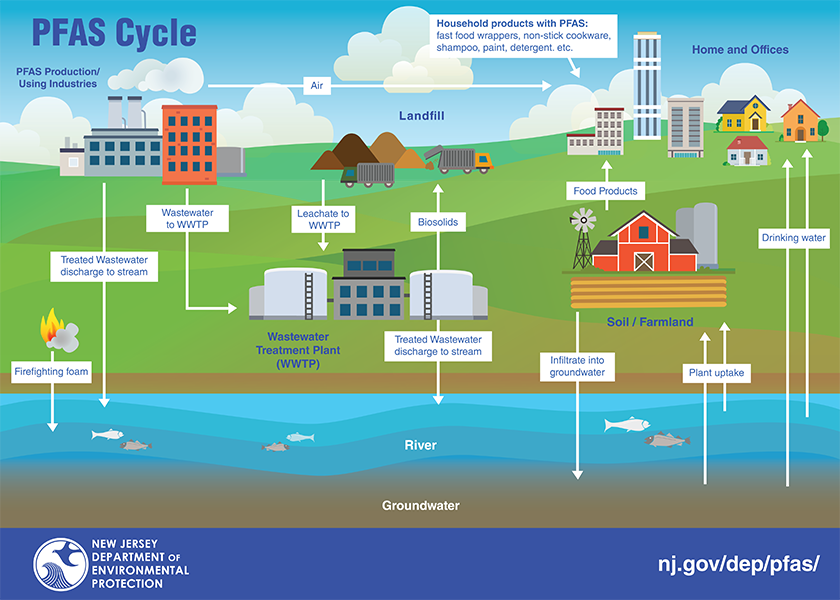
PFAS 101
PFAS, also known as “forever chemicals,” repel water and oil and are resistant to heat and chemical reactions.
What are PFAS?
Per- and polyfluoroalkyl substances, or PFAS, are a large family of thousands of manmade chemicals that have been used in industrial and commercial applications for over 70 years. PFAS, also known as “forever chemicals,” repel water and oil and are resistant to heat and chemical reactions.
Products that may be manufactured with PFAS include:
- Stain-resistant coatings for upholstery and carpets
- Water-resistant breathable clothing
- Greaseproof food packaging
- Non-stick cookware
- Aqueous film-forming foams used for extinguishing hydrocarbon fires and in firefighter training
How do PFAS get into the environment?
PFAS enter the environment through:
- Release from industrial facilities (through wastewater or air emissions) where they are made or used
- Release during firefighting training or use in response to a petroleum-based fire event
- Sludge and effluent from wastewater treatment plants
- Contaminated liquid from landfills (leachate) where PFAS containing industrial waste or consumer products are disposed
NJDEP currently regulates PFOA, PFOS, and PFNA because it was determined that these three PFAS occur in groundwater and drinking water at levels of concern.
Although the use of long-chain PFAS such as PFOA, PFOS, and PFNA has decreased substantially, contamination is expected to continue indefinitely because these substances are extremely persistent in the environment and are soluble and mobile in water.
What are the PFAS standards in New Jersey?
| Contaminant | MCL (μg/L or ppb)* | Ground Water Quality Standard (μg/L or ppb)* |
|---|---|---|
| PFOA | 0.014 | 0.014 |
| PFOS | 0.013 | 0.013 |
| PFNA | 0.013 | 0.013 |
| *micrograms per liter or parts per billion | ||
Additionally, NJDEP has recently established an Interim Specific Ground Water Quality Standard of 0.002 μg/L for another type of PFAS, chloroperfluoropolyether carboxylates (ClPFPECAs).
An MCL (Maximum Contaminant Level) is the highest allowable concentration of a contaminant in water delivered to a user of a public drinking water supply. MCLs apply to public water systems, including public community and public non-transient noncommunity water systems. Public community and public non-transient noncommunity water systems are required to routinely monitor for contaminants for which MCLs have been established and to take any action necessary to bring the water into compliance with an MCL.
The Ground Water Quality Standards establish classes of ground water according to the hydrogeologic characteristics of the ground water resource and the designated use(s) to be maintained, restored and enhanced within each classification area. Designated uses include maintenance of special ecological resources, provision of and conversion to potable water (drinking water), agricultural and industrial water supply, and other reasonable uses.
What is New Jersey doing about PFAS?
NJDEP has adopted rule amendments to:
- Establish drinking water Maximum Contaminant Levels (MCLs) for PFOA, PFOS, and PFNA;
- Expand testing of private wells subject to sale or lease for PFOA, PFOS, and PFNA under the Private Well Testing Act (PWTA);
- Establish specific Ground Water Quality Standards (GWQS) for PFOA, and PFOS, and PFNA;
- Add PFOA, and PFOS, and PFNA to New Jersey’s List of Hazardous Substances; and
- Expand the New Jersey Pollutant Discharge Elimination System (NJPDES) permit application testing requirements/pollutant listings and requirements for discharges to ground water to include PFOA, PFOS, and PFNA.
NJDEP has also established:
- an Interim Specific Ground Water Quality Criterion for ClPFPECAs
- Interim Soil and Soil Leachate Remediation Standards for PFNA, PFOA, PFOS, and GenX
- an Interim Specific Ground Water Quality Criterion for Hexafluoropropylene oxide dimer acid and its ammonium salt (HFPO-DA), also known as GenX.
NJDEP is currently:
- Developing Surface Water Quality Standards for PFOA, PFOS, and PFNA to protect human health and aquatic life.
